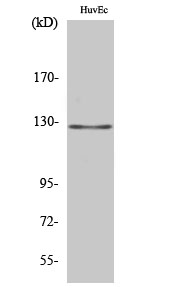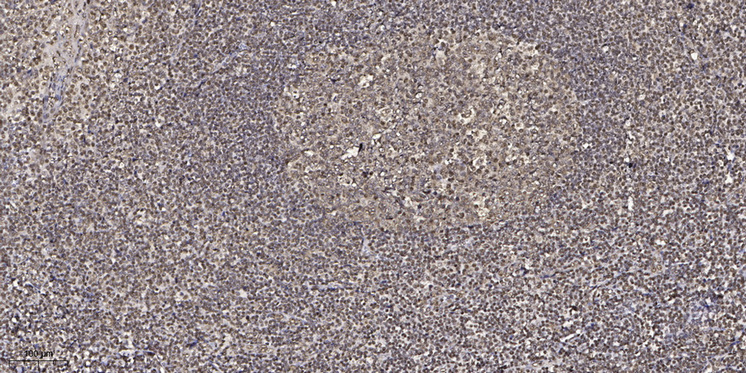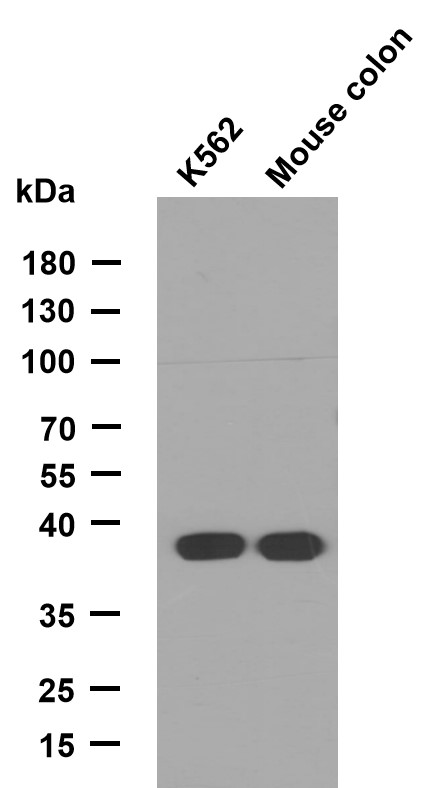MSH3 Polyclonal Antibody
- Catalog No.:YT2897
- Applications:WB;IHC;IF;ELISA
- Reactivity:Human;Mouse
- Target:
- MSH3
- Fields:
- >>Platinum drug resistance;>>Mismatch repair;>>Pathways in cancer;>>Colorectal cancer
- Gene Name:
- MSH3
- Protein Name:
- DNA mismatch repair protein Msh3
- Human Gene Id:
- 4437
- Human Swiss Prot No:
- P20585
- Mouse Swiss Prot No:
- P13705
- Immunogen:
- The antiserum was produced against synthesized peptide derived from human MSH3. AA range:51-100
- Specificity:
- MSH3 Polyclonal Antibody detects endogenous levels of MSH3 protein.
- Formulation:
- Liquid in PBS containing 50% glycerol, 0.5% BSA and 0.02% sodium azide.
- Source:
- Polyclonal, Rabbit,IgG
- Dilution:
- WB 1:500 - 1:2000. IHC 1:100 - 1:300. ELISA: 1:20000.. IF 1:50-200
- Purification:
- The antibody was affinity-purified from rabbit antiserum by affinity-chromatography using epitope-specific immunogen.
- Concentration:
- 1 mg/ml
- Storage Stability:
- -15°C to -25°C/1 year(Do not lower than -25°C)
- Other Name:
- MSH3;DUC1;DUG;DNA mismatch repair protein Msh3;hMSH3;Divergent upstream protein;DUP;Mismatch repair protein 1;MRP1
- Observed Band(KD):
- 127kD
- Background:
- The protein encoded by this gene forms a heterodimer with MSH2 to form MutS beta, part of the post-replicative DNA mismatch repair system. MutS beta initiates mismatch repair by binding to a mismatch and then forming a complex with MutL alpha heterodimer. This gene contains a polymorphic 9 bp tandem repeat sequence in the first exon. The repeat is present 6 times in the reference genome sequence and 3-7 repeats have been reported. Defects in this gene are a cause of susceptibility to endometrial cancer. [provided by RefSeq, Mar 2011],
- Function:
- disease:Defects in MSH3 are a cause of susceptibility to endometrial cancer [MIM:608089].,function:Component of the post-replicative DNA mismatch repair system (MMR). Heterodimerizes with MSH2 to form MutS beta which binds to DNA mismatches thereby initiating DNA repair. When bound, the MutS beta heterodimer bends the DNA helix and shields approximately 20 base pairs. MutS beta recognizes large insertion-deletion loops (IDL) up to 13 nucleotides long. After mismatch binding, forms a ternary complex with the MutL alpha heterodimer, which is thought to be responsible for directing the downstream MMR events, including strand discrimination, excision, and resynthesis.,PTM:Phosphorylated upon DNA damage, probably by ATM or ATR.,sequence caution:Contaminating sequence. Potential poly-A sequence.,similarity:Belongs to the DNA mismatch repair mutS family. MSH3 subfamily.,subunit:Heterodimer cons
- Subcellular Location:
- nuclear chromosome,nucleoplasm,membrane,MutSbeta complex,
- Expression:
- Muscle,
- June 19-2018
- WESTERN IMMUNOBLOTTING PROTOCOL
- June 19-2018
- IMMUNOHISTOCHEMISTRY-PARAFFIN PROTOCOL
- June 19-2018
- IMMUNOFLUORESCENCE PROTOCOL
- September 08-2020
- FLOW-CYTOMEYRT-PROTOCOL
- May 20-2022
- Cell-Based ELISA│解您多样本WB检测之困扰
- July 13-2018
- CELL-BASED-ELISA-PROTOCOL-FOR-ACETYL-PROTEIN
- July 13-2018
- CELL-BASED-ELISA-PROTOCOL-FOR-PHOSPHO-PROTEIN
- July 13-2018
- Antibody-FAQs
- Products Images

- Western Blot analysis of various cells using MSH3 Polyclonal Antibody diluted at 1:2000 cells nucleus extracted by Minute TM Cytoplasmic and Nuclear Fractionation kit (SC-003,Inventbiotech,MN,USA).

- Western blot analysis of lysates from HUVEC cells, using MSH3 Antibody. The lane on the right is blocked with the synthesized peptide.

- Immunohistochemical analysis of paraffin-embedded human tonsil. 1, Antibody was diluted at 1:200(4° overnight). 2, Tris-EDTA,pH9.0 was used for antigen retrieval. 3,Secondary antibody was diluted at 1:200(room temperature, 45min).



